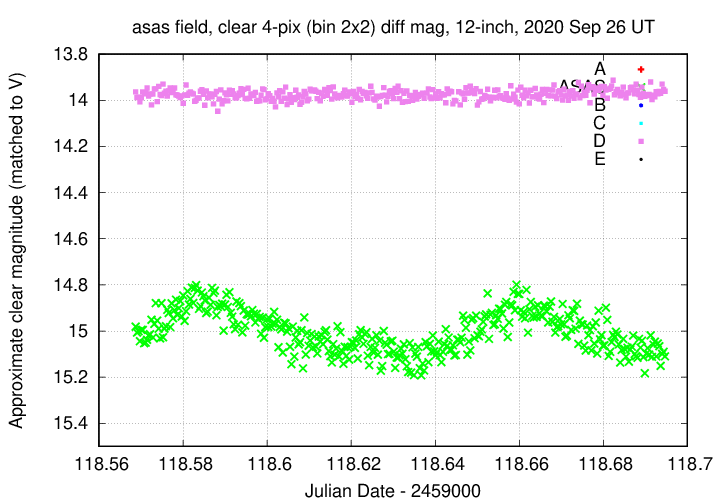
On the night of Sep 25/26, 2020, under good conditions, I acquired images of the star ASASSN-20mj. A message from Taichi Kato, sent to VSNet on Sep 23, 2020, requested observations of this possible CV.
ASASSN-20mj Large outburst amplitude. ASASSN-20mj --- ------- 21:45:41.52 34:22:58.9 2020-09-23.26 14.57 SDSS DSS VIZIER ------- CV candidate, matches to PS1 g=21.8, g>18.6 on 2020-09-18.46, g=14.9 on 2020-09-23.27. ASASSN-20mj 20200918.46 <186g ASN ASASSN-20mj 20200923.27 149g ASN The object was also in outburst in Carlsberg Meridian Catalog 15 (15.6 mag).
My measurements show that this star is undergoing a sinusoidal variation with a period of around 1.8 hours, and hence is very likely a CV in outburst.
You can find some basic information on this star at the ASAS-SN Transients page.
The main setup was:
Notes from the night:
The object is at
RA = 21:45:41.52 Dec = +34:22:58.9 (J2000)
A chart of the field is shown below. The size of the chart is about 16 x 16 arcminutes.

I've marked the location of several comparison stars.
star ID B V ------------------------------------------------------------------------- A APASS 11896379 11.554 10.970 B APASS 11896248 13.218 11.950 --------------------------------------------------------------------------
I took a photo of the finder TV's screen when pointing to ASASSN-20mj; this could be a useful reference for the future:

I ran the camera at the slightly-higher-than-normal temp of -19 C. Nothing out of the ordinary.

I took a series of 368 exposures of the field, using no filter and an exposure time of 20 seconds.
The sky value shows that the sky was mostly clear, and the Moon was setting as the night went on.

The number of objects detected. There's a dip near the end, for reasons I don't understand.

I used an aperture with radius 4.0 pixels tonight.


Using aperture photometry with a radius of 4 pixels (binned 2x2, each pixel is 1.25 arcsec, so a radius of 5.0 arcsec), I measured the instrumental magnitudes of a number of reference stars and the target. Following the procedures outlined by Kent Honeycutt's article on inhomogeneous ensemble photometry, I used all stars available in each image to define a reference frame, and measured each star against this frame.
Sigma-vs-mag plots show that the floor was about 0.007 mag overall.

Here are light curves of the variable and the field stars.

I used the SIMBAD value for the V-band magnitude of star "A" = APASS 11896379 to shift the ensemble UNFILTERED magnitudes to the standard V-band scale.
Here's a closeup on the variable. It shows a clear variation with a period of about 1.8 hours.

You can download my measurements below. A copy of the header of the file is shown to explain the format.
# Measurements of ASASSN-20mj made at RIT Obs, UT 2020 Sep 26, # in good conditions, # by Michael Richmond, # using Meade 12-inch LX200 and ATIK 11000. # Exposures 20 seconds long, clear filter. # Tabulated times are midexposure (FITS header time - half exposure length) # and accurate only to +/- 1 second (??). # 'mag' is a differential magnitude based on ensemble photometry # using a circular aperture of radius 4 pix = 5.0 arcseconds. # which has been shifted so APASS 11896379 has mag=10.97 # which is its V-band magnitude according to APASS. # # UT_day JD HJD mag uncert Sep26.06870 2459118.56870 2459118.57261 14.981 0.046 Sep26.06905 2459118.56905 2459118.57296 15.007 0.049
Last modified 9/26/2020 by MWR.